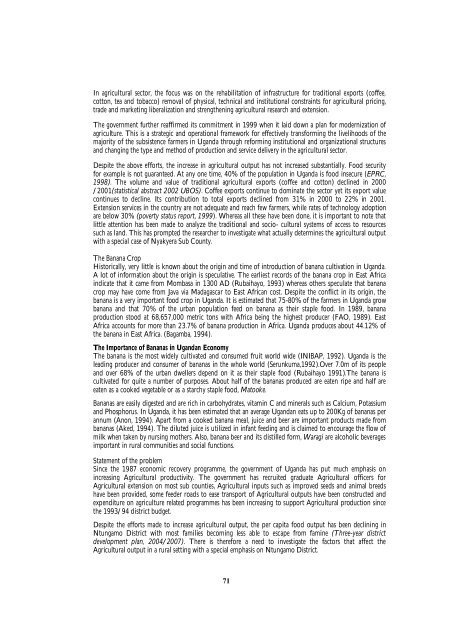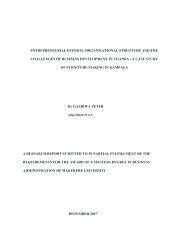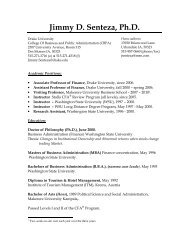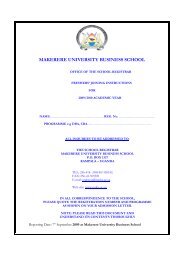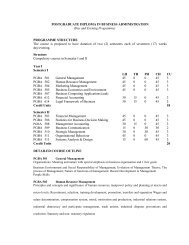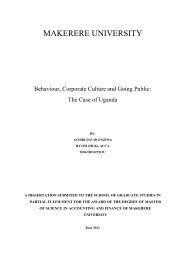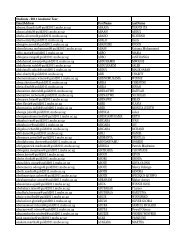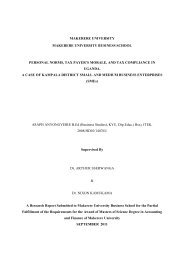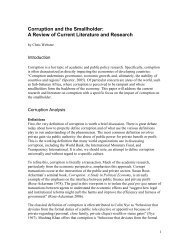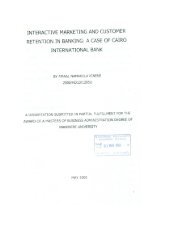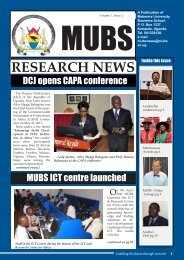13th Annual International Management Conference Proceeding
13th Annual International Management Conference Proceeding
13th Annual International Management Conference Proceeding
Create successful ePaper yourself
Turn your PDF publications into a flip-book with our unique Google optimized e-Paper software.
In agricultural sector, the focus was on the rehabilitation of infrastructure for traditional exports (coffee,<br />
cotton, tea and tobacco) removal of physical, technical and institutional constraints for agricultural pricing,<br />
trade and marketing liberalization and strengthening agricultural research and extension.<br />
The government further reaffirmed its commitment in 1999 when it laid down a plan for modernization of<br />
agriculture. This is a strategic and operational framework for effectively transforming the livelihoods of the<br />
majority of the subsistence farmers in Uganda through reforming institutional and organizational structures<br />
and changing the type and method of production and service delivery in the agricultural sector.<br />
Despite the above efforts, the increase in agricultural output has not increased substantially. Food security<br />
for example is not guaranteed. At any one time, 40% of the population in Uganda is food insecure (EPRC,<br />
1998). The volume and value of traditional agricultural exports (coffee and cotton) declined in 2000<br />
/2001(statistical abstract 2002 UBOS). Coffee exports continue to dominate the sector yet its export value<br />
continues to decline. Its contribution to total exports declined from 31% in 2000 to 22% in 2001.<br />
Extension services in the country are not adequate and reach few farmers, while rates of technology adoption<br />
are below 30% (poverty status report, 1999). Whereas all these have been done, it is important to note that<br />
little attention has been made to analyze the traditional and socio- cultural systems of access to resources<br />
such as land. This has prompted the researcher to investigate what actually determines the agricultural output<br />
with a special case of Nyakyera Sub County.<br />
The Banana Crop<br />
Historically, very little is known about the origin and time of introduction of banana cultivation in Uganda.<br />
A lot of information about the origin is speculative. The earliest records of the banana crop in East Africa<br />
indicate that it came from Mombasa in 1300 AD (Rubaihayo, 1993) whereas others speculate that banana<br />
crop may have come from Java via Madagascar to East African cost. Despite the conflict in its origin, the<br />
banana is a very important food crop in Uganda. It is estimated that 75-80% of the farmers in Uganda grow<br />
banana and that 70% of the urban population feed on banana as their staple food. In 1989, banana<br />
production stood at 68,657,000 metric tons with Africa being the highest producer (FAO, 1989). East<br />
Africa accounts for more than 23.7% of banana production in Africa. Uganda produces about 44.12% of<br />
the banana in East Africa. (Bagamba, 1994).<br />
The Importance of Bananas in Ugandan Economy<br />
The banana is the most widely cultivated and consumed fruit world wide (INIBAP, 1992). Uganda is the<br />
leading producer and consumer of bananas in the whole world (Serunkuma,1992).Over 7.0m of its people<br />
and over 68% of the urban dwellers depend on it as their staple food (Rubaihayo 1991).The banana is<br />
cultivated for quite a number of purposes. About half of the bananas produced are eaten ripe and half are<br />
eaten as a cooked vegetable or as a starchy staple food, Matooke.<br />
Bananas are easily digested and are rich in carbohydrates, vitamin C and minerals such as Calcium, Potassium<br />
and Phosphorus. In Uganda, it has been estimated that an average Ugandan eats up to 200Kg of bananas per<br />
annum (Anon, 1994). Apart from a cooked banana meal, juice and beer are important products made from<br />
bananas (Aked, 1994). The diluted juice is utilized in infant feeding and is claimed to encourage the flow of<br />
milk when taken by nursing mothers. Also, banana beer and its distilled form, Waragi are alcoholic beverages<br />
important in rural communities and social functions.<br />
Statement of the problem<br />
Since the 1987 economic recovery programme, the government of Uganda has put much emphasis on<br />
increasing Agricultural productivity. The government has recruited graduate Agricultural officers for<br />
Agricultural extension on most sub counties, Agricultural inputs such as improved seeds and animal breeds<br />
have been provided, some feeder roads to ease transport of Agricultural outputs have been constructed and<br />
expenditure on agriculture related programmes has been increasing to support Agricultural production since<br />
the 1993/94 district budget.<br />
Despite the efforts made to increase agricultural output, the per capita food output has been declining in<br />
Ntungamo District with most families becoming less able to escape from famine (Three-year district<br />
development plan, 2004/2007). There is therefore a need to investigate the factors that affect the<br />
Agricultural output in a rural setting with a special emphasis on Ntungamo District.<br />
71


